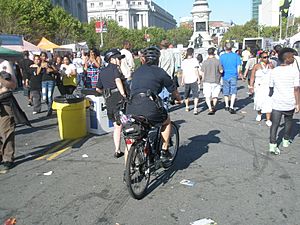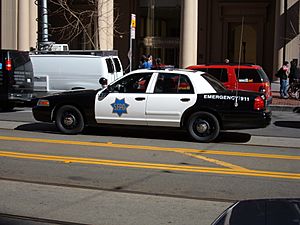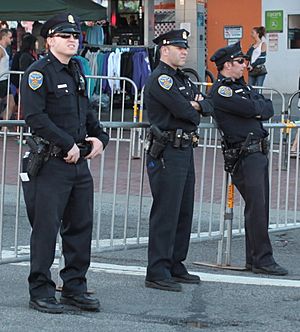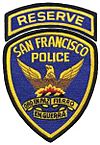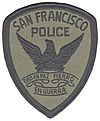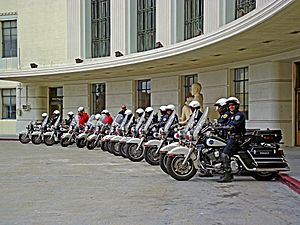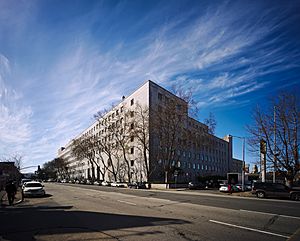San Francisco Police Department facts for kids
Quick facts for kids San Francisco Police Department |
|
|---|---|
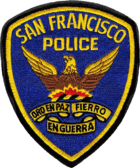
Patch
|
|
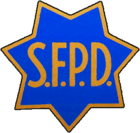
Vehicle door decal
|
|
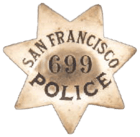
Badge
|
|
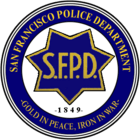
Commemorative decal
|
|
| Abbreviation | SFPD |
| Motto | Oro en paz, fierro en guerra Gold in peace, iron in war |
| Agency overview | |
| Formed | August 13, 1849 |
| Employees | 2,913 (2020) |
| Annual budget | $696 million (2020) |
| Jurisdictional structure | |
| Operations jurisdiction | San Francisco, California, USA |
 |
|
| Jurisdiction of the San Francisco Police Department, | |
| Population | 883,305 (2018) |
| Legal jurisdiction | As per operations jurisdiction |
| Governing body | San Francisco Police Commission |
| Operational structure | |
| Overviewed by Board | San Francisco Police Commission |
| Headquarters | Police Headquarters 1245 3rd St, San Francisco, 94158 |
| Officers | 2,140 |
| Patrol Specials | 28 |
| Commissioners responsible |
|
| Agency executive |
|
| Bureaus |
6
Administration
Airport Chief of Staff Field Operations Professional Standards and Principled Policing
Special Operations |
| Patrol Divisions |
2
Golden Gate
Metro |
| Facilities | |
| Stations | 10 |
| Airbases | 1 |
| Patrol cars | 338 |
| Boats | 5 |
| Planes | none |
| Dogs | 25+ |
The San Francisco Police Department (SFPD) is the main police force for the City and County of San Francisco. They also protect the San Francisco International Airport. The department's motto is Oro en paz, fierro en guerra. This is Spanish for Gold in peace, iron in war.
The SFPD is different from the San Francisco Sheriff's Department. Both are law enforcement groups in San Francisco. The SFPD helps keep safe an estimated 1.2 million people. This includes people who visit or commute to the city. San Francisco is one of the most crowded big cities in North America. In 2000, the SFPD was the 11th largest police department in the United States.
Contents
- History of the SFPD
- How the SFPD is Organized
- SFPD Equipment
- SFPD Rank Structure
- San Francisco Police Reserve Officers
- SFPD SWAT Team
- Housing Authority Police
- C.R.U.S.H. Unit
- SFPD Motor Division
- SFPD Aero Division (Air Support)
- SFPD Police Academy
- SFPD Headquarters
- SFPD in Popular Culture
- SFPD Stations
- SFPD Demographics
- SFPD Chiefs of Police
- See also
History of the SFPD
The San Francisco Police Department has a long and interesting history. It started during the exciting Gold Rush days.
Early Days of the SFPD
The SFPD started on August 13, 1849. This was during the Gold Rush. Captain Malachi Fallon was in charge. At first, he had only one deputy captain, three sergeants, and 30 officers.
In 1853, the city decided to reorganize the police department. They passed a law called Ordinance No. 466. This law said the police department would have 56 men. This included a Captain and an assistant Captain. The Captains were chosen by city leaders. Other officers were appointed by the Mayor and other officials.
In 1856, a new law called the "Consolidation Act" came into effect. This law created the job of Chief of Police. The first Chief of Police was James F. Curtis. The SFPD was one of the first police forces to use modern law enforcement methods in the early 1900s.
The 1975 Strike
In August 1975, SFPD officers went on strike. They were unhappy about their pay. This strike was against a California law that said police could not strike. The city tried to get them back to work with a court order. But the officers kept striking. Only managers and African-American officers stayed on duty. Mayor Joseph Alioto declared a state of emergency. He then agreed to the officers' demands.
Recent Times for the SFPD
In 1997, the police at San Francisco International Airport joined the SFPD. They became the SFPD Airport Bureau.
Before 2011, officers used Beretta Model 96GT pistols. These were .40 caliber guns. They replaced older .38 Special revolvers. The SFPD was one of the last big agencies in California to use semi-automatic pistols.
On September 8, 2011, work began on a new Public Safety Building (PSB). This new building is in Mission Bay. It is the new home for the SFPD Headquarters. It also has a police station and a fire station.
In 2014, the San Francisco Police Academy had its first publicly known transgender police officer graduate. Her name was Mikayla Connell.
A study in 2017 showed something interesting. The San Francisco Police Department doubled its foot patrols. This means more officers walked around the city. This led to a 16% drop in theft and a 19% drop in assaults.
How the SFPD is Organized
The San Francisco Police Department is led by a Chief of Police. The Mayor of San Francisco chooses this chief. The chief works with two assistant chiefs and five deputy chiefs. These leaders manage six main sections called bureaus. These bureaus handle different parts of police work.
SFPD Bureaus
The department has six bureaus. Each is led by an Assistant Chief or Deputy Chief.
| Bureau | Commander | What They Do | Divisions |
|---|---|---|---|
| Administration Bureau | Chief of Administration | This bureau handles the department's money, computers, legal advice, and staff. | It has 6 divisions, including Forensic Services and Training. |
| Airport Bureau | Chief of Airport | This bureau provides police services, traffic control, and safety at the San Francisco International Airport. | N/A |
| Chief of Staff | Chief of Staff | This office helps the Chief of Police. They also manage media relations and internal affairs. | This office oversees 6 divisions, including Risk Management and Internal Affairs. |
| Field Operations Bureau | Chief of Field Operations | This bureau manages the Patrol Division and Investigations Bureau. | Patrol is split into Golden Gate Division and Metro Division. |
| Professional Standards and Principled Policing Bureau | Chief of Professional Standards and Principled Policing | This bureau started in 2016. It helps make sure officers use force properly. It also works with the U.S. Department of Justice. | N/A |
| Special Operations Bureau | Chief of Special Operations | This bureau helps other units with special skills and tools. | It includes Homeland Security, Municipal Transportation, and the Tactical Company. This company has the SWAT team, Bomb Squad, and Canine Unit. |
SFPD Equipment
SFPD officers use specific equipment to do their jobs.
The standard handguns are the SIG Sauer P226 and SIG Sauer P229. These guns use .40 S&W bullets. Officers also carry batons, pepper spray, a radio, and handcuffs. Some officers can also carry AR-15 rifles.
SFPD Vehicles
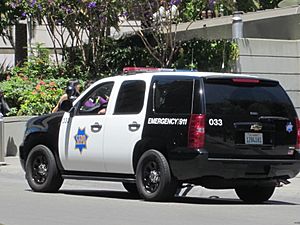
The SFPD uses several types of vehicles. These include Trek Bicycle Corporation bicycles. They also use Ford Crown Victoria Police Interceptor cars and Chevrolet Tahoe SUVs. More recently, they added 2013 Ford Taurus cars and 2013 Ford Explorer SUVs.
Most SFPD patrol cars are black with white roofs. The front doors have a blue seven-pointed star. It has "S.F.P.D." written in gold. The car's identification number is on the doors and roof. This helps air units see them. On the back, there's a sticker that says "EMERGENCY DIAL 911".
SFPD Uniform
- The standard uniform is a dark blue shirt and pants. It has black trim and brass buttons. The buttons have the city seal and "SF POLICE" on them. The black stripe on the pants gets wider for higher ranks.
- Mounted police have a gold stripe on their pants.
- Traffic Company officers have a "winged wheel" patch on their right sleeve.
- The Peaked cap has an 8-point design. It has a brass hat piece with the San Francisco city arms.
- The "badge" is called a "star" by the department. Officers wear a silver seven-point star. Sergeants and higher ranks have engraved designs on their stars. Inspectors and higher ranks wear gold-filled stars.
- A patch was added to the uniform in 1970. It has the San Francisco crest of arms, a phoenix, and the city motto.
SFPD Rank Structure
The SFPD has different ranks, like in the military. Each rank has its own special sign.
| Title | Insignia |
|---|---|
| Chief | |
| Assistant Chief | |
| Deputy Chief | |
| Commander | |
| Captain | |
| Lieutenant | |
| Sergeant | |
| Inspector | |
| Assistant Inspector | |
| Officer |
Officers can also have special levels based on their training. For example, a Q-2, Q-3, or Q-4 Police Officer. Inspectors wear a gold star badge. Sergeants and officers wear a silver star badge. Officers with many years of service have blue and gold stripes on their uniform sleeves. Each stripe means five years of service.
SFPD members can also earn Medals of Valor. These are bronze, silver, and gold awards for bravery. They can also get a Meritorious Conduct Award.
San Francisco Police Reserve Officers
The San Francisco Police Reserve Officer Unit is made up of volunteers. These people want to help their city. They understand how important good policing is. But they cannot be full-time police officers.
A San Francisco Police Reserve Officer is a certified police officer. They volunteer their time. They have the same duties and power as a full-time officer when they are on duty. They patrol in cars, on bikes, or on foot. Some even patrol on boats. Reserve officers must meet the same strict training rules as regular officers. Most are Level 1 Reserve Officers, which is the highest level in California.
Reserve Officers must volunteer at least 24 hours each month. Many volunteer two or three times that much. They help with many types of police work. This includes patrol, special events, and DUI checkpoints. They also help transport prisoners.
Reserve Officers are organized into squads. They work together for special events like New Year's Eve. Before joining, candidates must meet the same requirements as regular officers. They must also complete special training. They are held to the same high standards as full-time officers.
SFPD SWAT Team
San Francisco has a special SWAT team. These are volunteer officers chosen from the whole department. They get a lot of their training in-house. They also train with the FBI and other federal agencies. The SWAT team works with agencies like the FBI and DEA. They respond quickly to emergencies. They also carry out high-risk warrants. They are known for their "crime suppression" efforts. This means they put many officers in high-crime areas to prevent crime.
Housing Authority Police
The San Francisco Housing Authority Police was created in 1938. They patrolled the city's housing projects. In the 1990s, this group became part of the main Police Department.
C.R.U.S.H. Unit
In the mid-1990s, San Francisco saw a rise in murders. Chief Fred Lau created a special task force. It was called CRime Unit to Stop Homicide (CRUSH). This unit's job was to solve murders and stop violent crimes. Experienced officers were chosen for this important unit.
SFPD Motor Division
The SFPD was one of the first departments to use Police motorcycles. Their motorcycle unit started in 1909. It is part of the SFPD Traffic Division. They help with traffic, patrol, and special events. They are the only department in the nation that uses all its motorcycles for escorts.
The unit has 43 officers. They are based at the Hall of Justice. They often patrol alone, which is why they are called "SOLOS." Most of their motorcycles are Harley-Davidson Road King models. There is also a "Honda Unit" with Suzuki DR-Z400S motorcycles. These are used for city patrol and in Golden Gate Park. Each of the 10 main police stations also has two motorcycles for local patrol.
SFPD Aero Division (Air Support)
The SFPD used to have an "Aero" Squadron with helicopters and small planes in the 1970s. After some accidents, the unit was stopped. One helicopter crashed in Lake Merced in 1971, killing an officer. The unit was restarted in the late 1990s. But after another fatal crash, the Aero unit was put on hold. Now, if the SFPD needs air support, they ask the California Highway Patrol for help.
SFPD Police Academy
The first San Francisco Police Academy was built in 1895. It was near Golden Gate Park. The current San Francisco Police Academy Complex was built in the 1960s. It was first a school. It is located at 350 Amber Drive. The building is now used for police training. It is surrounded by trees and near a shopping area.
As of 2008, there are three academy classes each year. Each class lasts 31 to 32 weeks. Many officers are expected to retire soon. This means about 700 new officers will be hired in the next 5–10 years. So, the academy will be busy. Pier 94 is used for vehicle training. Lake Merced is where officers practice shooting.
SFPD Headquarters
For 56 years, the SFPD headquarters was at the San Francisco Thomas J. Cahill Hall of Justice. This building also had courts, jails, and police units. The San Francisco Sheriff's Department headquarters is next door. On April 16, 2015, the SFPD moved its headquarters. The new location is in Mission Bay.
SFPD in Popular Culture
The SFPD has been shown in many movies and TV shows.
- Movies: The Sniper, Vertigo, Bullitt, the Dirty Harry movies, 48 Hrs., Rush Hour, and Zodiac.
- TV Series: The Streets of San Francisco, McMillan & Wife, Nash Bridges, The Division, and Monk.
- The Dirty Harry movies made many people think of the department as tough on crime.
In old radio shows, there were many dramas about the SFPD. Carlton E. Morse created four shows based on SFPD files for NBC. These included Chinatown Squad and Barbary Coast Nights.
The SFPD has also appeared in many books and short stories. Authors like Sidney Herschel Small and Breni James wrote about SFPD officers. Ernest K. Gann's 1963 novel, Of Good and Evil, is about a San Francisco police chief. More recently, Collin Wilcox wrote about Lieutenant Frank Hastings from SFPD's Homicide Detail. Laurie R. King wrote about Homicide Inspector Kate Martinelli. James Patterson's novels about Homicide Inspector Lindsay Boxer became best-sellers.
Some books about the SFPD explore the city's history. With Siberia Comes a Chill (1990) is set in 1945. White Rabbit by David Daniels is set during the 1967 Summer of Love.
A future version of the SFPD is in the video game Call of Duty: Advanced Warfare. They try to stop drones from destroying the Golden Gate Bridge. In the iOS game Cause of Death, the main characters are SFPD officers. One character, Malachi "Mal" Fallon, is named after the real Malachi Fallon, the first SFPD captain.
The SFPD has been made into fictional police departments. For example, the San Fierro Police Department in the video game Grand Theft Auto: San Andreas. Also, the San Fransokyo Police Department in the 2014 animated film Big Hero 6.
The character Teresa Lisbon from The Mentalist TV show used to be with the SFPD. Beau from Colony was an SFPD veteran. In the movie Sonic the Hedgehog, Tom Wachowski almost joined the SFPD.
SFPD Stations
The SFPD has 10 main police stations and some smaller substations.
Metro Division:
- 1) Central Station: 766 Vallejo St. San Francisco, CA 94133
- 2) Mission Station: 630 Valencia St. San Francisco, CA 94110
- 3) Northern Station: 1125 Fillmore St. San Francisco, CA 94115
- 4) Southern Station, Public Safety Building: 1251 3rd St. San Francisco, CA 94103
- 5) Tenderloin Station: 301 Eddy St. San Francisco, CA 94102
Golden Gate Division:
- 6) Bayview Station: 201 Williams Ave. San Francisco, CA 94124
- 7) Ingleside Station: 1 Sgt. John V. Young Ln. San Francisco, CA 94112-2408
- 8) Park Station: 1899 Waller Street San Francisco, CA 94117
- 9) Richmond Station: 461 6th Ave San Francisco, CA 94118
- 10) Taraval Station: 2345 24th Ave. San Francisco, CA 94116
Sub Station and Special Division
- 11) San Francisco Police Academy: 350 Amber Dr San Francisco, CA 94131
- 12) San Francisco International Airport Police: International Terminal, 5th floor
SFPD Demographics
This shows the makeup of the SFPD staff:
- Male: 85.15%
- Female: 14.85%
- White: 49.39%
- Hispanic: 16.46%
- Asian: 16.55%
- African-American/Black: 9.58%
- Filipino: 5.79%
- Native American/ Alaska Native: 0.30%
- Other: 1.35%
- Unknown: 0.57%
The department has become much more diverse since 1972. Back then, only 150 out of 2000 officers were not white.
SFPD Chiefs of Police
Here is a list of the Chiefs of Police for the San Francisco Police Department:
| Name | Term | ||
|---|---|---|---|
| Malachi Fallon | 1849–1850 | ||
| Brandt Sequine | 1851–? | ||
| John W. McKenzie | ?–1856 | ||
| James F. Curtis | 1856–1858 | ||
| Martin J. Burke | 1858–1866 | ||
| Patrick Crowley | 1866–1873 | ||
| Theodore G. Cockrill | 1873–1875 | ||
| Henry H. Ellis | 1875–1877 | ||
| John Kirkpatrick | 1877–1879 | ||
| Patrick Crowley | 1879–1897 | ||
| Isaiah W. Lees | 1897–1900 | ||
| William P. Sullivan | 1900–1901 | ||
| George Wittman | 1901–1905 | ||
| Jeremiah F. Dinan | 1905–1907 | ||
| William J. Biggy | 1907–1908 | ||
| Jesse B. Cook | 1908–1910 | ||
| John B. Martin | 1910 | ||
| John Seymour | 1910–1911 | ||
| David A. White | 1911–1920 | ||
| Daniel J. O'Brien | 1920–1928 | ||
| William J. Quinn | 1929–1940 | ||
| Charles W. Dullea | 1940–1947 | ||
| Michael Riordan | 1947 | ||
| Michael Mitchell | 1948–1950 | ||
| Michael Gaffey | 1951–1955 | ||
| George Healy | 1955–1956 | ||
| Francis J. Ahern | 1956–1958 | ||
| Thomas J. Cahill | 1958–1970 | ||
| Alfred J. Nelder | 1970–1971 | ||
| Donald M. Scott | 1971–1975 | ||
| Charles Gain | 1975–1980 | ||
| Corneilius P. Murphy | 1980–1986 | ||
| Frank M. Jordan | 1986–1990 | ||
| Willis Casey | 1990–1992 | ||
| Richard D. Hongisto | 1992 | ||
| Anthony Ribera | 1992–1996 | ||
| Fred H. Lau | 1996–2002 | ||
| Prentice E. Sanders | 2002–2003 | ||
| Alex Fagan | 2003–2004 | ||
| Heather Fong | 2004–2009 | ||
| George Gascón | 2009–2011 | ||
| Greg Suhr | 2011–2016 | ||
| Toney Chaplin | 2016 | ||
| William Scott | 2016–present | Source: | |
See also
 In Spanish: Departamento de Policía de San Francisco para niños
In Spanish: Departamento de Policía de San Francisco para niños


